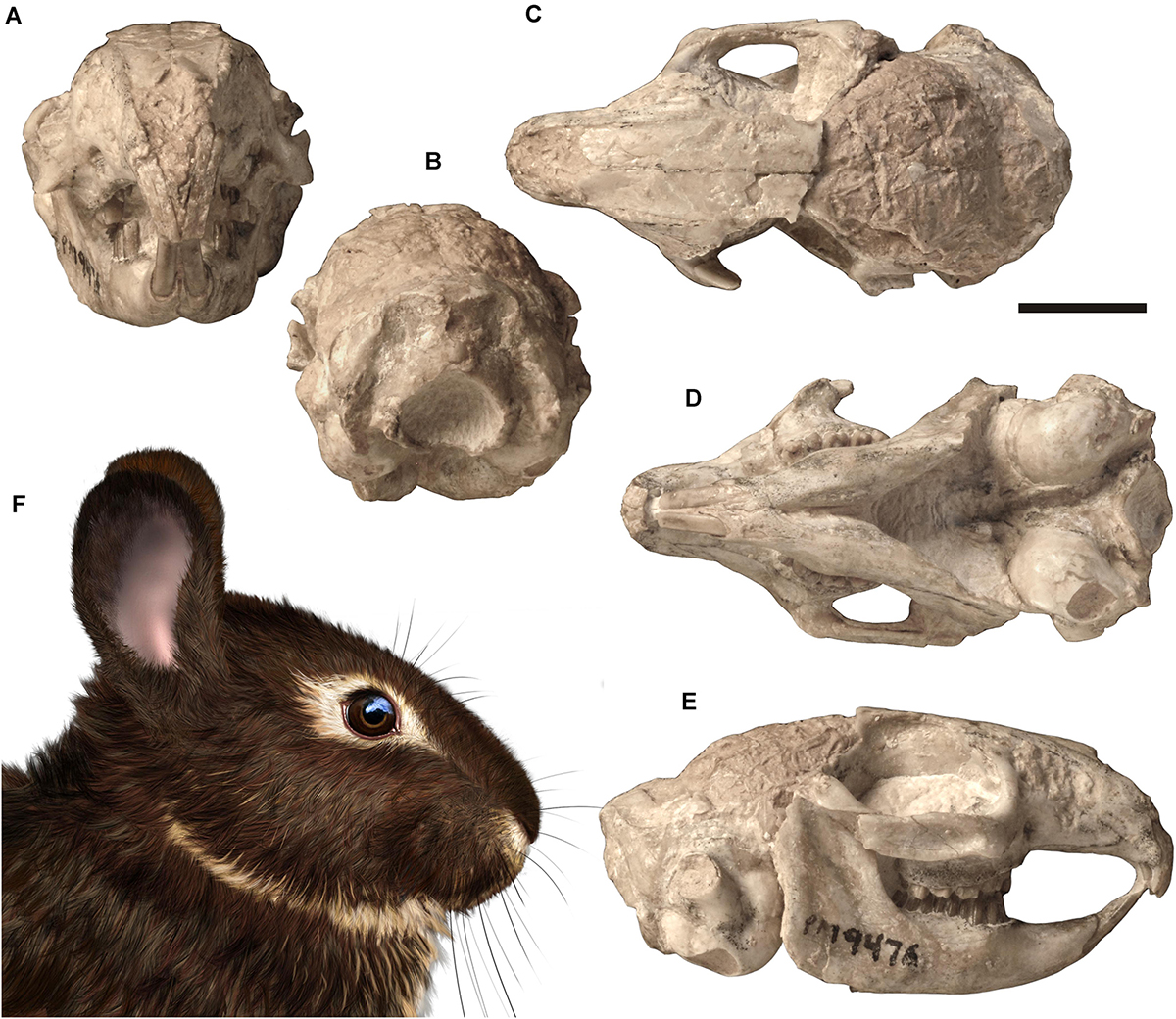Post by Infinity Blade on Aug 15, 2015 18:48:12 GMT 5
Palaeolagus spp.

Palaeolagus haydeni. © @ Nobu Tamura->.
Temporal range: Paleogene; Late Eocene to Early Miocene; Priabonian to end Aquitanian (Early Chadronian to end Arikareean); 37.2-20.43 Ma[1][2]
Scientific classification:
Life
Domain: Eukaryota
(unranked): Unikonta
(unranked): Opisthokonta
(unranked): Holozoa
(unranked): Filozoa
Kingdom: Animalia
Subkingdom: Eumetazoa
(unranked): Bilateria
Clade: Nephrozoa
Superphylum: Deuterostomia
Phylum: Chordata
Clade: Cephalochordata
Clade: Craniata
Subphylum: Vertebrata
Infraphylum: Gnathostomata
Clade: Eugnathostomata
Clade: Teleostomi
Superclass: Tetrapoda
Clade: Reptiliomorpha
Clade: Amniota
Clade: Synapsida
Clade: Eupelycosauria
Clade: Sphenacodontia
Clade: Sphenacodontoidea
Order: Therapsida
Clade: Eutheriodonta
Suborder: Cynodontia
Clade: Epicynodontia
Infraorder: Eucynodontia
Parvorder: Probainognathia
Superfamily: Chiniquodontoidea
Clade: Prozostrodontia
Clade: Mammaliaformes
Class: Mammalia
Clade: Holotheria
Superlegion: Trechnotheria
Legion: Cladotheria
Sublegion: Zatheria
Infralegion: Tribosphenida
Subclass: Theria
Clade: Eutheria
Infraclass: Placentalia
Subcohort: Exafroplacentalia
Magnorder: Boreoeutheria
Superorder: Euarchontoglires
(unranked): Glires
Order: Lagomorpha
Genus: †Palaeolagus
Species: †P. burkei
†P. haydeni
†P. hemirhizis
†P. hypsodus
†P. intermedius
†P. philoi
†P. primus
†P. temnodon
Palaeolagus ('ancient hare') was an extinct genus of stem-lagomorph that lived in North America during the Eocene, Oligocene, and early Miocene epochs.[1][2]
Description:
Superficially, Palaeolagus looked similar to modern rabbits. Upon closer inspection, however, Palaeolagus appears to have lacked the postcranial specializations modern rabbits have for saltatorial locomotion.[3] It also had an akinetic skull, unlike the kinetic skulls modern rabbits possess (thought to be an adaptation for shock absorption as they land on the ground).[4] As such, Palaeolagus was a non-cursorial, non-saltatorial genus that still scampered (although, it appears to show the early signs of evolving saltatorial locomotion).[3][4]
Diet:
Palaeolagus possessed hypsodont dentition.[1] This suggests it had a diet and/or feeding habits that placed a substantial amount of wear on its teeth.

A fossil of P. haydeni.
Phylogenetic placement:
Micro-CT scans of the skull of P. haydeni have revealed that its skull had several leporid-like and ochotonid-like characters in its skull. Out of 46 characters, it shared 21 with leporids and 13 with ochotonids. It possessed 7 characters shared in common with both families, but also possessed 5 characters with a morphology unlike any of the crown lagomorphs. This lends support to previous placements of Palaeolagus as a stem-lagomorph.[5]
References:
[1] Graham, A. (1999). Late Cretaceous and Cenozoic history of North American vegetation: north of Mexico. Oxford University Press on Demand.
[2] Paleobiology Database – Palaeolagus
[3] Scott, W. B., Jepsen, G. L., & Wood, A. E. (1940). The Mammalian Fauna of the White River Oligocene: Part III. Lagomorpha. Transactions of the American Philosophical Society, 28(3), 271-362.
[4] Bramble, D. M. (1989). Cranial specialization and locomotor habit in the Lagomorpha. American zoologist, 29(1), 303-317.
[5] Wolniewicz AS and Fostowicz-Frelik Ł (2021) CT-Informed Skull Osteology of Palaeolagus haydeni (Mammalia: Lagomorpha) and Its Bearing on the Reconstruction of the Early Lagomorph Body Plan. Front. Ecol. Evol. 9:634757. doi: 10.3389/fevo.2021.634757

Palaeolagus haydeni. © @ Nobu Tamura->.
Temporal range: Paleogene; Late Eocene to Early Miocene; Priabonian to end Aquitanian (Early Chadronian to end Arikareean); 37.2-20.43 Ma[1][2]
Scientific classification:
Life
Domain: Eukaryota
(unranked): Unikonta
(unranked): Opisthokonta
(unranked): Holozoa
(unranked): Filozoa
Kingdom: Animalia
Subkingdom: Eumetazoa
(unranked): Bilateria
Clade: Nephrozoa
Superphylum: Deuterostomia
Phylum: Chordata
Clade: Cephalochordata
Clade: Craniata
Subphylum: Vertebrata
Infraphylum: Gnathostomata
Clade: Eugnathostomata
Clade: Teleostomi
Superclass: Tetrapoda
Clade: Reptiliomorpha
Clade: Amniota
Clade: Synapsida
Clade: Eupelycosauria
Clade: Sphenacodontia
Clade: Sphenacodontoidea
Order: Therapsida
Clade: Eutheriodonta
Suborder: Cynodontia
Clade: Epicynodontia
Infraorder: Eucynodontia
Parvorder: Probainognathia
Superfamily: Chiniquodontoidea
Clade: Prozostrodontia
Clade: Mammaliaformes
Class: Mammalia
Clade: Holotheria
Superlegion: Trechnotheria
Legion: Cladotheria
Sublegion: Zatheria
Infralegion: Tribosphenida
Subclass: Theria
Clade: Eutheria
Infraclass: Placentalia
Subcohort: Exafroplacentalia
Magnorder: Boreoeutheria
Superorder: Euarchontoglires
(unranked): Glires
Order: Lagomorpha
Genus: †Palaeolagus
Species: †P. burkei
†P. haydeni
†P. hemirhizis
†P. hypsodus
†P. intermedius
†P. philoi
†P. primus
†P. temnodon
Palaeolagus ('ancient hare') was an extinct genus of stem-lagomorph that lived in North America during the Eocene, Oligocene, and early Miocene epochs.[1][2]
Description:
Superficially, Palaeolagus looked similar to modern rabbits. Upon closer inspection, however, Palaeolagus appears to have lacked the postcranial specializations modern rabbits have for saltatorial locomotion.[3] It also had an akinetic skull, unlike the kinetic skulls modern rabbits possess (thought to be an adaptation for shock absorption as they land on the ground).[4] As such, Palaeolagus was a non-cursorial, non-saltatorial genus that still scampered (although, it appears to show the early signs of evolving saltatorial locomotion).[3][4]
Diet:
Palaeolagus possessed hypsodont dentition.[1] This suggests it had a diet and/or feeding habits that placed a substantial amount of wear on its teeth.

A fossil of P. haydeni.
Phylogenetic placement:
Micro-CT scans of the skull of P. haydeni have revealed that its skull had several leporid-like and ochotonid-like characters in its skull. Out of 46 characters, it shared 21 with leporids and 13 with ochotonids. It possessed 7 characters shared in common with both families, but also possessed 5 characters with a morphology unlike any of the crown lagomorphs. This lends support to previous placements of Palaeolagus as a stem-lagomorph.[5]
References:
[1] Graham, A. (1999). Late Cretaceous and Cenozoic history of North American vegetation: north of Mexico. Oxford University Press on Demand.
[2] Paleobiology Database – Palaeolagus
[3] Scott, W. B., Jepsen, G. L., & Wood, A. E. (1940). The Mammalian Fauna of the White River Oligocene: Part III. Lagomorpha. Transactions of the American Philosophical Society, 28(3), 271-362.
[4] Bramble, D. M. (1989). Cranial specialization and locomotor habit in the Lagomorpha. American zoologist, 29(1), 303-317.
[5] Wolniewicz AS and Fostowicz-Frelik Ł (2021) CT-Informed Skull Osteology of Palaeolagus haydeni (Mammalia: Lagomorpha) and Its Bearing on the Reconstruction of the Early Lagomorph Body Plan. Front. Ecol. Evol. 9:634757. doi: 10.3389/fevo.2021.634757





